牛津译林版八年级下册Unit 7 International Charities Period 3 课件 (共25张PPT)
文档属性
| 名称 | 牛津译林版八年级下册Unit 7 International Charities Period 3 课件 (共25张PPT) | 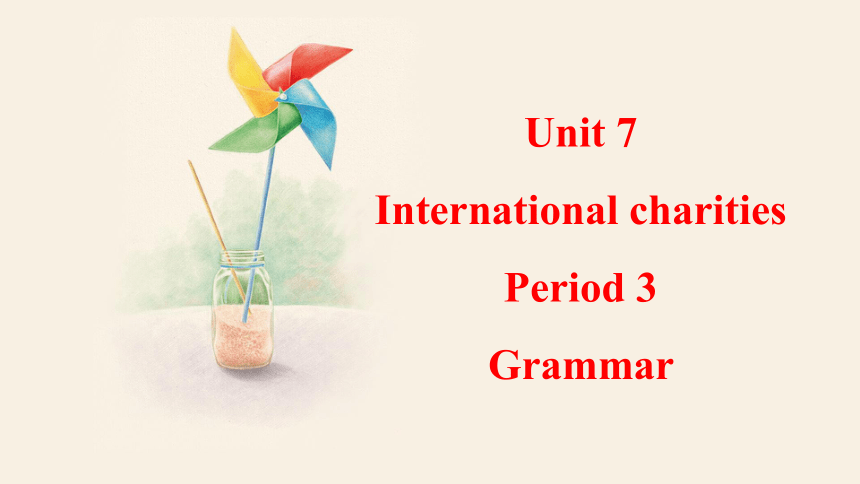 | |
| 格式 | pptx | ||
| 文件大小 | 1.2MB | ||
| 资源类型 | 教案 | ||
| 版本资源 | 牛津译林版 | ||
| 科目 | 英语 | ||
| 更新时间 | 2023-12-29 10:04:36 | ||
图片预览




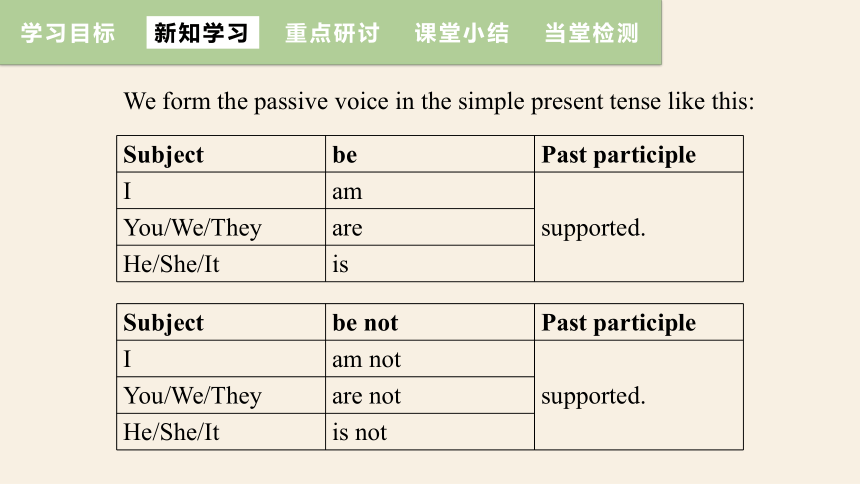

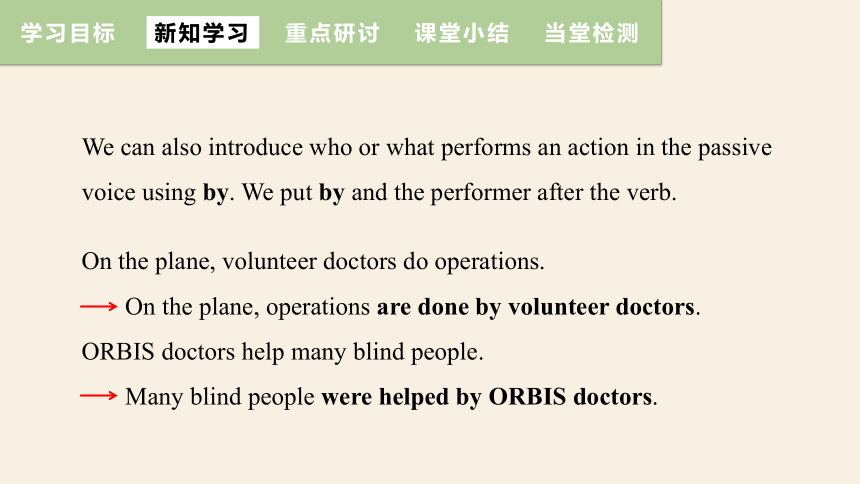
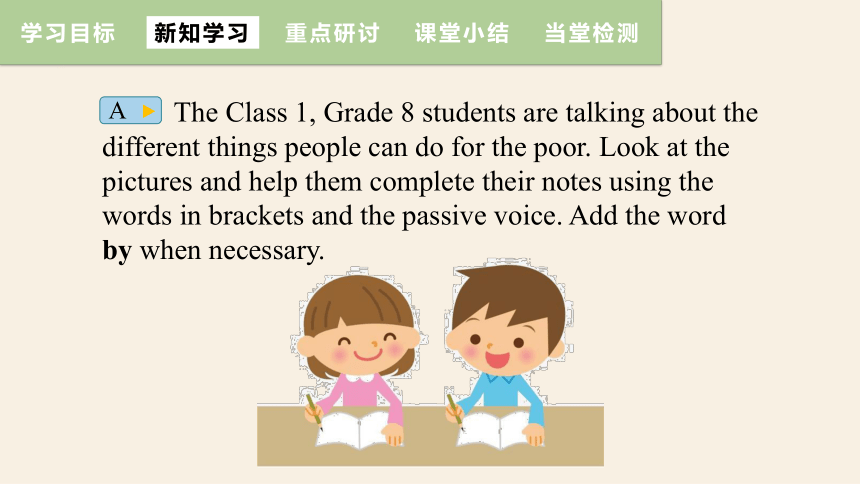
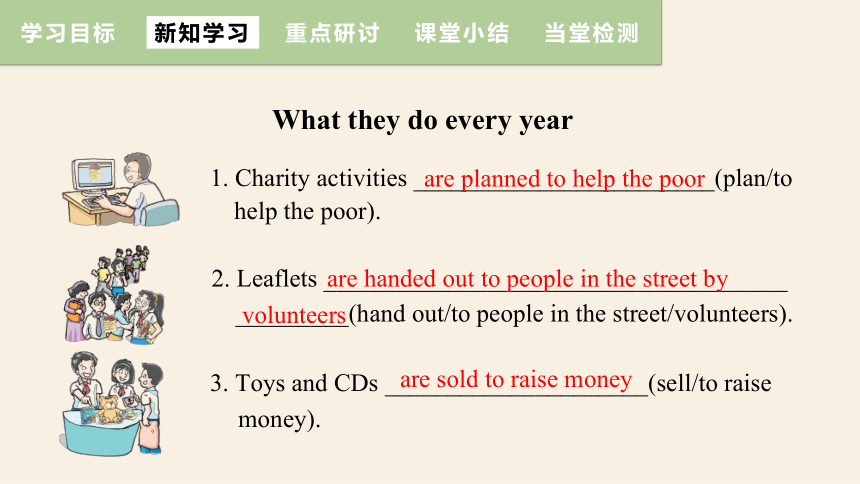
文档简介
(共25张PPT)
Unit 7
International charities
Period 3
Grammar
新
课
导
入
Look and say
1. Eddie, more money is needed for charity.
2. ..., and about 80 per cent of these cases can be prevented or cured.
3. The plan is also used as a training centre.
4. Also, local doctors and nurses are invited on board to learn about eye problems.
Language Goal
1. 能熟悉并正确运用本课时的重点单词和短语。
2. 能掌握被动语态的一般现在时和一般过去时。
新知学习
课堂小结
当堂检测
学习目标
重点研讨
新知学习
课堂小结
当堂检测
学习目标
重点研讨
Passive voice in the simple present and past tenses
We use the active voice when it is important to know who performs the action.
Volunteer doctors do operations on the plane.
We use the passive voice when
it is obvious who performs the action.
The plane is used as a training centre.
we do not know or do not need to know who performs the action.
His eye problem was cured two months ago.
the action is more important than the person who performs the action.
The lives of the patients with eye problems are improved.
新知学习
课堂小结
当堂检测
学习目标
重点研讨
We form the passive voice in the simple present tense like this:
Subject be Past participle
I am supported.
You/We/They are
He/She/It is
Subject be not Past participle
I am not supported.
You/We/They are not
He/She/It is not
新知学习
课堂小结
当堂检测
学习目标
重点研讨
We form the passive voice in the simple past tense like this:
Subject be Past participle
I was supported.
You/We/They were
He/She/It was
Subject be not Past participle
I was not supported.
You/We/They were not
He/She/It was not
新知学习
课堂小结
当堂检测
学习目标
重点研讨
We can also introduce who or what performs an action in the passive voice using by. We put by and the performer after the verb.
On the plane, volunteer doctors do operations.
On the plane, operations are done by volunteer doctors.
ORBIS doctors help many blind people.
Many blind people were helped by ORBIS doctors.
新知学习
课堂小结
当堂检测
学习目标
重点研讨
The Class 1, Grade 8 students are talking about the different things people can do for the poor. Look at the pictures and help them complete their notes using the words in brackets and the passive voice. Add the word by when necessary.
▲
A
新知学习
课堂小结
当堂检测
学习目标
重点研讨
1. Charity activities ________________________(plan/to help the poor).
are planned to help the poor
2. Leaflets _____________________________________ _________(hand out/to people in the street/volunteers).
are handed out to people in the street by
volunteers
3. Toys and CDs _____________________(sell/to raise money).
are sold to raise money
What they do every year
新知学习
课堂小结
当堂检测
学习目标
重点研讨
5. Warm clothes __________________________
(collect/for poor people).
were collected for poor people
6. A charity show ____________________________ (hold/the Students' Union).
was held by the Students' Union
4. New books ______________________________ ___________________________(send/to children in poor areas/the Class 1, Grade 8 students).
were sent to children in poor areas
by the Class 1, Grade 8 students
What they did last week
新知学习
课堂小结
当堂检测
学习目标
重点研讨
Amy and Daniel are talking about plete their conversation with the words in brackets using the passive voice.
▲
B
新知学习
课堂小结
当堂检测
学习目标
重点研讨
Amy: I'm reading a book about Oxfam.
Daniel: Really Please tell me about it.
Amy: OK. Oxfam ___________ (set up) in the UK in 1942, and the first Oxfam shop __________ (open) in 1948. Now it has about 15,000 shops all over the world. A lot of things _________ (sell) in Oxfam shops, including books. The money _______ (use) by Oxfam to help poor people.
Daniel: That's good. There are also some charity projects in China. One of them ________ (call) Project Hope. It __________ (start) in 1989. With its help, millions of poor children all over the country __________ (give) basic education.
Amy: Yes. Many schools __________ (build) in poor areas each year.
was set up
was opened
is called
was started
were given
are built
are sold
is used
新知学习
课堂小结
当堂检测
学习目标
重点研讨
1. Leaflets are handed out to people in the street by volunteers.
志愿者在街上向人们散发传单。
hand out 分发;提出
e.g. One of my jobs was to hand out the prizes.
我的工作之一是分发奖品。
Language Points
2. Oxfam was set up in the UK in 1942, ...
乐施会于1942年在英国成立,……
set up 建起,设立
e.g. He has just set up his own business.
他刚建立起自己的公司。
新知学习
课堂小结
当堂检测
学习目标
重点研讨
被动语态的一般现在时和一般过去时
语态是动词的一种形式,表示的是主语和谓语之间的关系。英语中的语态有两种:主动语态和被动语态。
当主语是谓语的执行者时,用主动语态。当主语是谓语的承受者时,用被动语态。如:
We clean the classroom every day. 我们每天都打扫教室。
The classroom is cleaned (by us) every day.
教室每天都被(我们)打扫。
新知学习
课堂小结
当堂检测
学习目标
重点研讨
被动语态的基本构成:
主语 be动词 过去分词
一般现在时 I am supported.
You/We/They are
He/She/It is
一般过去时 I was supported.
You/We/They were
He/She/It was
新知学习
课堂小结
当堂检测
学习目标
重点研讨
被动语态的基本用法:
1. 动作的执行者是泛指或不言自明时。如:
None of the books was taken away.
没有一本书被拿走。
2. 在不知道动作的执行者是谁时。如:
The toy is designed for children.
这款玩具是为了孩子们设计的。
3. 需要强调动作的承受者时。如:
My bike was repaired.
我的自行车修好了。
新知学习
课堂小结
当堂检测
学习目标
重点研讨
4. 出于委婉或礼貌而避谈动作的执行者时。如:
This problem was talked about just now.
这个问题刚才被讨论过。
5. 在被动语态的句子中,如果我们需要指出动
作的执行者,可以由by引出。如:
Mr Wu is liked by all of his students.
所有的学生都喜欢吴老师。
注意:有些动词常用被动语态。如:
He was born in Nanjing. 他生于南京。
This mobile phone was made in China.
这部手机是由中国制造的。
新知学习
课堂小结
当堂检测
学习目标
重点研讨
主动语态与被动语态的句式转化:
主动语态 主语 She 谓语(主动式) hurt 宾语
me.
被动语态 原宾语(改为主格) I 谓语(被动式) was hurt by 原主语(改为宾格)
her.
主语 + 谓语 + 双宾语的句式转化:
主动语态 主语 He 谓语(主动式) passed 间宾 me 直宾
a book.
被动语态 原直宾 A book 谓语(被动式) was passed to me by 原主语(改为宾格)
him.
原间宾(改为主格) I 谓语(被动式) was passed 原直宾 a book by 原主语(改为宾格)
him.
新知学习
课堂小结
当堂检测
学习目标
重点研讨
第一步:主宾互换。
第二步:谓语动词变为“be+过去分词”,并通过be的变化来表达出不同的时态。
第三步: “be+过去分词” + by +原主语。
(有时by+原主语可省)
第四步:时间、地点状语等保持一致。
主变被四步曲
主动语态变被动语态
新知学习
课堂小结
当堂检测
学习目标
重点研讨
主动语态变被动语态的口诀
宾变主,主变宾,by短语后面跟。
谓语动词变被动,be后“过分”来使用。
“be”要随着主语变,人称时态要弄准。
新知学习
课堂小结
当堂检测
学习目标
重点研讨
注意:1. 有些动词,其主动语态形式含有被动意义。如:系动词smell、taste、sound、feel等。
The dish smells good. 这道菜闻起来很香。
The music sounds nice. 这段音乐听起来不错。
还有一些不及物动词,常用主动语态,和well、easily等副词连用,含有被动意义。如:read、write、draw、smell、wash、cook、clean等。
The books sell well. 这些书很畅销。
The pen writes smoothly. 这支笔写起来很顺滑。
新知学习
课堂小结
当堂检测
学习目标
重点研讨
2. 在感官动词和使役动词的主动语态句式中,动词不定式的to常省去,但是在被动语态中要加上to。
主动语态 主语 The teacher 谓语(主动式) made 宾语 him 不带to的不定式
retell the story.
被动语态 原宾语(改为主格) He 谓语(被动式) was made 带to的不定式 to retell the story by 原主语(改为宾格)
the teacher.
新知学习
课堂小结
当堂检测
学习目标
重点研讨
重点单词和短语:
leaflet, hold, set, including, hand out, set up
被动语态的一般现在时和一般过去时:
被动语态的一般现在时
肯定句结构:_______________________________
否定句结构:_______________________________
被动语态的一般过去时
肯定句结构:_______________________________
否定句结构:_______________________________
Unit 7
Period 3
主语+am/is/are +过去分词+其他.
主语+am/is/are +not+过去分词+其他.
主语+was/were+过去分词+其他.
主语+ was/were+not+过去分词+其他.
新知学习
课堂小结
当堂检测
学习目标
重点研讨
一、判断下列句子是主动语态还是被动语态。
1. The lights were turned off by Tom.
2. The windows are cleaned every week.
3. Millie's closed the door.
4. The TV was turned on.
5. The boy made a model plane.
6. A total (总数) of 8 questions are answered.
Passive
Passive
Active
Passive
Active
Passive
新知学习
课堂小结
当堂检测
学习目标
重点研讨
二、把下列句子变成被动语态。
2. They do their homework after school.
Their homework is done by them after school.
The light was invented by Thomas Edison.
3. Thomas Edison invented the light.
The flowers were watered by him this morning.
4. He watered the flowers this morning.
1. He plays basketball every week.
Basketball is played by him every week.
Unit 7
International charities
Period 3
Grammar
新
课
导
入
Look and say
1. Eddie, more money is needed for charity.
2. ..., and about 80 per cent of these cases can be prevented or cured.
3. The plan is also used as a training centre.
4. Also, local doctors and nurses are invited on board to learn about eye problems.
Language Goal
1. 能熟悉并正确运用本课时的重点单词和短语。
2. 能掌握被动语态的一般现在时和一般过去时。
新知学习
课堂小结
当堂检测
学习目标
重点研讨
新知学习
课堂小结
当堂检测
学习目标
重点研讨
Passive voice in the simple present and past tenses
We use the active voice when it is important to know who performs the action.
Volunteer doctors do operations on the plane.
We use the passive voice when
it is obvious who performs the action.
The plane is used as a training centre.
we do not know or do not need to know who performs the action.
His eye problem was cured two months ago.
the action is more important than the person who performs the action.
The lives of the patients with eye problems are improved.
新知学习
课堂小结
当堂检测
学习目标
重点研讨
We form the passive voice in the simple present tense like this:
Subject be Past participle
I am supported.
You/We/They are
He/She/It is
Subject be not Past participle
I am not supported.
You/We/They are not
He/She/It is not
新知学习
课堂小结
当堂检测
学习目标
重点研讨
We form the passive voice in the simple past tense like this:
Subject be Past participle
I was supported.
You/We/They were
He/She/It was
Subject be not Past participle
I was not supported.
You/We/They were not
He/She/It was not
新知学习
课堂小结
当堂检测
学习目标
重点研讨
We can also introduce who or what performs an action in the passive voice using by. We put by and the performer after the verb.
On the plane, volunteer doctors do operations.
On the plane, operations are done by volunteer doctors.
ORBIS doctors help many blind people.
Many blind people were helped by ORBIS doctors.
新知学习
课堂小结
当堂检测
学习目标
重点研讨
The Class 1, Grade 8 students are talking about the different things people can do for the poor. Look at the pictures and help them complete their notes using the words in brackets and the passive voice. Add the word by when necessary.
▲
A
新知学习
课堂小结
当堂检测
学习目标
重点研讨
1. Charity activities ________________________(plan/to help the poor).
are planned to help the poor
2. Leaflets _____________________________________ _________(hand out/to people in the street/volunteers).
are handed out to people in the street by
volunteers
3. Toys and CDs _____________________(sell/to raise money).
are sold to raise money
What they do every year
新知学习
课堂小结
当堂检测
学习目标
重点研讨
5. Warm clothes __________________________
(collect/for poor people).
were collected for poor people
6. A charity show ____________________________ (hold/the Students' Union).
was held by the Students' Union
4. New books ______________________________ ___________________________(send/to children in poor areas/the Class 1, Grade 8 students).
were sent to children in poor areas
by the Class 1, Grade 8 students
What they did last week
新知学习
课堂小结
当堂检测
学习目标
重点研讨
Amy and Daniel are talking about plete their conversation with the words in brackets using the passive voice.
▲
B
新知学习
课堂小结
当堂检测
学习目标
重点研讨
Amy: I'm reading a book about Oxfam.
Daniel: Really Please tell me about it.
Amy: OK. Oxfam ___________ (set up) in the UK in 1942, and the first Oxfam shop __________ (open) in 1948. Now it has about 15,000 shops all over the world. A lot of things _________ (sell) in Oxfam shops, including books. The money _______ (use) by Oxfam to help poor people.
Daniel: That's good. There are also some charity projects in China. One of them ________ (call) Project Hope. It __________ (start) in 1989. With its help, millions of poor children all over the country __________ (give) basic education.
Amy: Yes. Many schools __________ (build) in poor areas each year.
was set up
was opened
is called
was started
were given
are built
are sold
is used
新知学习
课堂小结
当堂检测
学习目标
重点研讨
1. Leaflets are handed out to people in the street by volunteers.
志愿者在街上向人们散发传单。
hand out 分发;提出
e.g. One of my jobs was to hand out the prizes.
我的工作之一是分发奖品。
Language Points
2. Oxfam was set up in the UK in 1942, ...
乐施会于1942年在英国成立,……
set up 建起,设立
e.g. He has just set up his own business.
他刚建立起自己的公司。
新知学习
课堂小结
当堂检测
学习目标
重点研讨
被动语态的一般现在时和一般过去时
语态是动词的一种形式,表示的是主语和谓语之间的关系。英语中的语态有两种:主动语态和被动语态。
当主语是谓语的执行者时,用主动语态。当主语是谓语的承受者时,用被动语态。如:
We clean the classroom every day. 我们每天都打扫教室。
The classroom is cleaned (by us) every day.
教室每天都被(我们)打扫。
新知学习
课堂小结
当堂检测
学习目标
重点研讨
被动语态的基本构成:
主语 be动词 过去分词
一般现在时 I am supported.
You/We/They are
He/She/It is
一般过去时 I was supported.
You/We/They were
He/She/It was
新知学习
课堂小结
当堂检测
学习目标
重点研讨
被动语态的基本用法:
1. 动作的执行者是泛指或不言自明时。如:
None of the books was taken away.
没有一本书被拿走。
2. 在不知道动作的执行者是谁时。如:
The toy is designed for children.
这款玩具是为了孩子们设计的。
3. 需要强调动作的承受者时。如:
My bike was repaired.
我的自行车修好了。
新知学习
课堂小结
当堂检测
学习目标
重点研讨
4. 出于委婉或礼貌而避谈动作的执行者时。如:
This problem was talked about just now.
这个问题刚才被讨论过。
5. 在被动语态的句子中,如果我们需要指出动
作的执行者,可以由by引出。如:
Mr Wu is liked by all of his students.
所有的学生都喜欢吴老师。
注意:有些动词常用被动语态。如:
He was born in Nanjing. 他生于南京。
This mobile phone was made in China.
这部手机是由中国制造的。
新知学习
课堂小结
当堂检测
学习目标
重点研讨
主动语态与被动语态的句式转化:
主动语态 主语 She 谓语(主动式) hurt 宾语
me.
被动语态 原宾语(改为主格) I 谓语(被动式) was hurt by 原主语(改为宾格)
her.
主语 + 谓语 + 双宾语的句式转化:
主动语态 主语 He 谓语(主动式) passed 间宾 me 直宾
a book.
被动语态 原直宾 A book 谓语(被动式) was passed to me by 原主语(改为宾格)
him.
原间宾(改为主格) I 谓语(被动式) was passed 原直宾 a book by 原主语(改为宾格)
him.
新知学习
课堂小结
当堂检测
学习目标
重点研讨
第一步:主宾互换。
第二步:谓语动词变为“be+过去分词”,并通过be的变化来表达出不同的时态。
第三步: “be+过去分词” + by +原主语。
(有时by+原主语可省)
第四步:时间、地点状语等保持一致。
主变被四步曲
主动语态变被动语态
新知学习
课堂小结
当堂检测
学习目标
重点研讨
主动语态变被动语态的口诀
宾变主,主变宾,by短语后面跟。
谓语动词变被动,be后“过分”来使用。
“be”要随着主语变,人称时态要弄准。
新知学习
课堂小结
当堂检测
学习目标
重点研讨
注意:1. 有些动词,其主动语态形式含有被动意义。如:系动词smell、taste、sound、feel等。
The dish smells good. 这道菜闻起来很香。
The music sounds nice. 这段音乐听起来不错。
还有一些不及物动词,常用主动语态,和well、easily等副词连用,含有被动意义。如:read、write、draw、smell、wash、cook、clean等。
The books sell well. 这些书很畅销。
The pen writes smoothly. 这支笔写起来很顺滑。
新知学习
课堂小结
当堂检测
学习目标
重点研讨
2. 在感官动词和使役动词的主动语态句式中,动词不定式的to常省去,但是在被动语态中要加上to。
主动语态 主语 The teacher 谓语(主动式) made 宾语 him 不带to的不定式
retell the story.
被动语态 原宾语(改为主格) He 谓语(被动式) was made 带to的不定式 to retell the story by 原主语(改为宾格)
the teacher.
新知学习
课堂小结
当堂检测
学习目标
重点研讨
重点单词和短语:
leaflet, hold, set, including, hand out, set up
被动语态的一般现在时和一般过去时:
被动语态的一般现在时
肯定句结构:_______________________________
否定句结构:_______________________________
被动语态的一般过去时
肯定句结构:_______________________________
否定句结构:_______________________________
Unit 7
Period 3
主语+am/is/are +过去分词+其他.
主语+am/is/are +not+过去分词+其他.
主语+was/were+过去分词+其他.
主语+ was/were+not+过去分词+其他.
新知学习
课堂小结
当堂检测
学习目标
重点研讨
一、判断下列句子是主动语态还是被动语态。
1. The lights were turned off by Tom.
2. The windows are cleaned every week.
3. Millie's closed the door.
4. The TV was turned on.
5. The boy made a model plane.
6. A total (总数) of 8 questions are answered.
Passive
Passive
Active
Passive
Active
Passive
新知学习
课堂小结
当堂检测
学习目标
重点研讨
二、把下列句子变成被动语态。
2. They do their homework after school.
Their homework is done by them after school.
The light was invented by Thomas Edison.
3. Thomas Edison invented the light.
The flowers were watered by him this morning.
4. He watered the flowers this morning.
1. He plays basketball every week.
Basketball is played by him every week.
